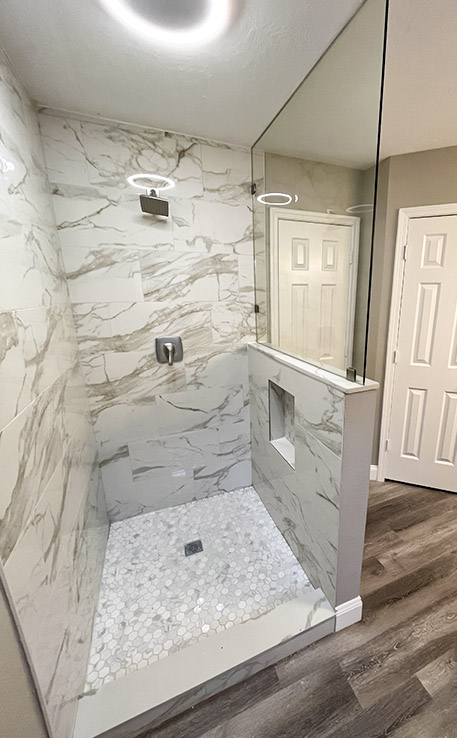Home renovations can be an exciting way to express yourself and add value to your home. In this article, we explore the different aspects of house renovation that should be taken into consideration when deciding which part of the house is best to renovate.
We will look at both aesthetic and financial considerations to help you make a smart decision for your own home renovation project.
The size and layout of the space being renovated, along with any architectural features or style preferences, are all important factors in determining what kind of renovation would work best for your particular situation.
Additionally, taking into account current trends in home design, as well as potential return on investment (ROI) estimates can also be helpful in making sure that you get the most out of your renovation project.
Size And Layout Of The Space
When it comes to renovating a house, one of the most important elements is size and layout. Consideration must be given to space utilization in order for the renovation project to be successful.
It can often times prove difficult when attempting to maximize any available room within an existing structure. In some cases, making small changes such as rearranging furniture may do the trick; however, larger projects involving structural alterations might also have to be taken into account.
Room arrangement plays an integral part when designing renovations that are tailored specifically to meet individual needs and preferences. The number of rooms and their purpose should always take priority over aesthetics alone.
For example, if you need more living area than dining area, then your design will reflect this by having fewer walls or partitions dedicated towards cooking areas but instead opting for open-plan spaces for seating or lounging purposes. Taking these factors into consideration before starting any major construction work is essential in ensuring that desired results are achieved from the outset.

Architectural Features And Style Preferences
Architectural features and style preferences vary from region to region, influenced by the historical context of an area.
For instance, in a colonial area with centuries-old buildings, renovation projects may focus on restoring original elements that reflect the traditional architecture. Conversely, in more modern areas where new construction is prevalent, renovations are often focused around bringing contemporary design into older homes.
No matter what part of house a homeowner is renovating, they should consider regional influences when selecting materials and designs. This could involve looking up examples of surrounding houses to gain inspiration or researching local regulations regarding building codes and restrictions.
A great way to learn about regional architectural styles is to visit museums that honor local structures and review books written about specific regions’ history and culture. Ultimately, homeowners need to weigh their own individual tastes with what works best for their particular location when it comes time to decide which type of renovation project will be most successful.
Aesthetics And Functionality
When renovating a house, aesthetics and functionality must be taken into consideration. Design principles such as color coordination, texture selection, and lighting should be followed in order to achieve the desired look for the home.
In addition, energy efficiency has become an essential factor when selecting materials and appliances. Energy efficient windows, insulation, water heaters, stoves and other home systems can help homeowners save money on their electricity bills while also reducing their carbon footprint.
The kitchen is often seen as one of the most important rooms to renovate due to its central function within the home. Renovations can include improved ventilation systems or installation of new countertops that are both aesthetically pleasing and functional.
Appliances with advanced features such as self-cleaning ovens or programmable coffee makers can add convenience to daily life by making tasks easier and faster. Additionally, installing smart thermostats or motion sensor lights can help reduce energy consumption even further.
Making these upgrades not only increases comfort but could potentially increase property value if it is done properly.
Current Trends In Home Design
The home renovation industry is continuously evolving and current trends are heavily focused on green design principles and eco friendly materials.
Homeowners seeking to invest in their property have the opportunity to create a unique living space that is both aesthetically pleasing and environmentally conscious.
From solar power systems to sustainably sourced building materials, there are numerous ways for homeowners to make an impact with their renovations while achieving excellent results.
Incorporating energy-efficient appliances can also reduce utility bills, as well as help protect the environment by reducing carbon emissions.
In addition, choosing natural or sustainable materials such as bamboo flooring or recycled glass countertops prevents unnecessary waste production and helps promote long term sustainability goals.
By selecting these options when renovating any part of their house, homeowners can simultaneously improve their quality of life while making sure they leave behind a better world for future generations.
Potential Return On Investment
When it comes to renovations, understanding the potential return on investment is essential.
It is important to assess renovation costs against the improvement value they will bring in order to determine which area of the house should be renovated first.
The cost involved in renovating a particular part of a home can vary greatly depending upon its size, complexity and type of materials used.
In addition, some improvements may add more than just aesthetic value but also increase energy efficiency or functionality.
Therefore, it is prudent to weigh all considerations when deciding where to make investments into home renovations.
It is worth noting that while certain parts of a home are typically more expensive to renovate—such as bathrooms and kitchens—they are often able to attract higher returns due to their increased appeal for buyers.
However, other areas such as attics or basements have better chances of increasing profit margins if done properly since there is usually less competition from surrounding homes with similar upgrades already completed.
Ultimately, homeowners must consider both short-term and long-term goals when making decisions about what area(s) of their house should be renovated first in order maximize return on investment.
Impact On Property Value
Renovating a home is an investment that can yield substantial returns. While the decision to renovate should not be taken lightly, certain areas of the house can produce larger returns than others upon resale.
One such area is energy efficiency and climate control, which are two components that buyers look for when evaluating potential properties. When it comes to making a property more efficient, investing in newer windows or insulation can help reduce heating and cooling costs over time while also improving air quality.
This type of renovation will create immediate savings on utility bills and will likely improve the overall comfort level throughout the home by providing better climate control. Moreover, these upgrades often result in higher resale value as they demonstrate an effort toward modernizing the property and preparing it for long-term sustainability.

This makes them attractive investments for prospective buyers looking for homes that prioritize energy-efficiency and climate control features.
Cost Considerations
Renovating a home can be an expensive undertaking, but it can also be a great way to increase the value of your property. It is important for homeowners to consider their budget when deciding what part of their house to renovate.
DIY projects are generally more cost-effective than hiring professional contractors and have become increasingly popular in recent years due to lower costs and advances in technology that allow even novice do-it-yourselfers to undertake sophisticated designs.
Energy efficiency should also be considered during any renovation project as investing in green energy solutions will pay off over time with lower utility bills. Insulating walls, improving ventilation systems, upgrading windows, and installing solar panels are all ways to improve the sustainability of a home while adding value at the same time.
Additionally, many local governments offer tax credits or other incentives for investments in renewable energy sources. By taking these factors into account before starting a renovation project, homeowners can make informed decisions about which parts of their house will provide them with the most return on investment while staying within their desired budget range.
Conclusion
When deciding which part of the house to renovate, it is important to consider size and layout of the space, architectural features and style preferences, aesthetics and functionality, current trends in home design, potential return on investment, impact on property value and cost considerations.
Ultimately, homeowners should select a renovation project based upon their individual needs and budget.
With careful consideration given to these factors before starting any project, homeowners can be confident that they are making an informed decision about which area of their home to remodel.
A successful renovation will not only enhance the beauty of the home but also add significant value to it for years to come.


